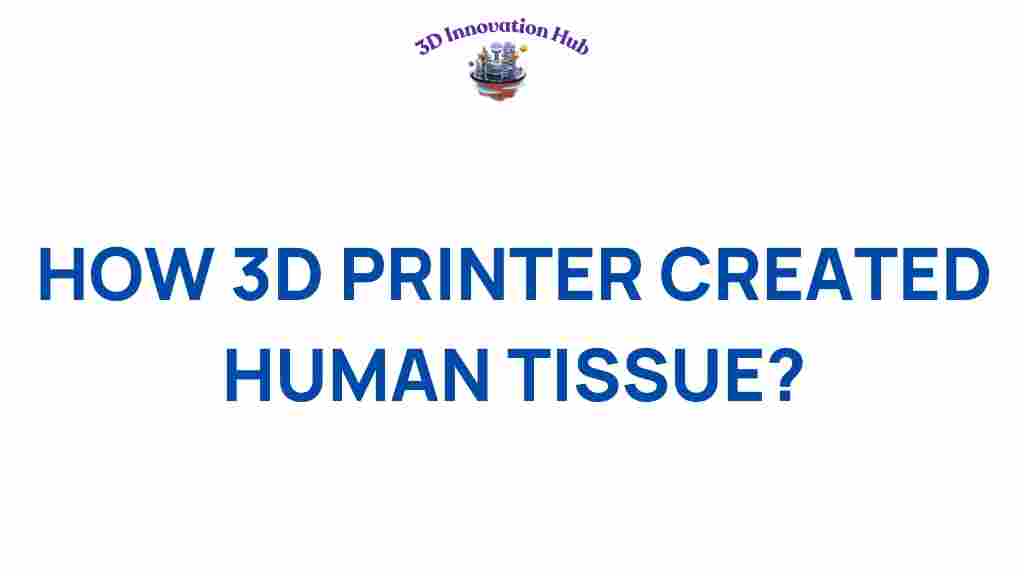How 3D Printers Are Revolutionizing Human Tissue Creation
The advent of 3D printing technology has ushered in a new era of innovation, particularly in the field of healthcare. Among the most significant advancements is the ability to create human tissue through a process known as bioprinting. This groundbreaking technique not only enhances our understanding of tissue engineering but also holds the potential to transform regenerative medicine and overall healthcare technology.
In this article, we will explore the various dimensions of 3D printing in human tissue creation, the implications for medical innovation, and the future of bioprinting in healthcare. Along the way, we’ll delve into the types of biomaterials used, the step-by-step processes involved, and troubleshooting tips for those interested in this fascinating field.
The Basics of 3D Printing and Bioprinting
At its core, 3D printing refers to the additive manufacturing process where materials are layered to create a three-dimensional object. In the context of human tissue, this involves the use of living cells and biomaterials to print tissues that can mimic the structure and function of natural organs.
Bioprinting is a specific type of 3D printing that utilizes bio-inks—combinations of living cells and materials—to produce tissue structures. This technology allows researchers and clinicians to create complex tissue architectures, paving the way for personalized medicine and advanced therapeutic solutions.
The Role of Biomaterials in Tissue Engineering
Biomaterials are critical in the field of tissue engineering. They serve as the scaffold that supports cell growth and tissue formation. The choice of biomaterials can significantly affect the viability and functionality of the printed tissue. Commonly used biomaterials include:
- Hydrogels: Water-based materials that provide a natural environment for cell growth.
- Collagen: A protein found in the extracellular matrix that supports tissue structure.
- Decellularized ECM: Extracellular matrix stripped of cells, retaining its natural structure and biochemical cues.
- Polymers: Synthetic materials that can be engineered for specific mechanical and degradation properties.
Each of these biomaterials has distinct properties that can be tailored for specific applications in regenerative medicine.
Step-by-Step Process of Bioprinting Human Tissues
The process of bioprinting human tissues involves several key steps:
1. Design and Modeling
Before printing, researchers design the tissue structure using computer-aided design (CAD) software. This model represents the desired shape and layout of the tissue.
2. Selection of Biomaterials
Choosing the appropriate biomaterials is crucial. Factors such as biocompatibility, mechanical strength, and degradation rate are considered during this phase.
3. Preparation of Bio-ink
The selected biomaterials are mixed with living cells to create a bio-ink. This mixture must maintain cell viability while having the right viscosity for printing.
4. Printing Process
The bio-ink is loaded into a 3D printer equipped with a bioprinting head. Layer by layer, the printer deposits the bio-ink according to the designed model.
5. Culturing
After printing, the tissue constructs are placed in a bioreactor. This environment provides the necessary nutrients and conditions for cell growth and tissue maturation.
6. Testing and Quality Control
Finally, the printed tissues undergo rigorous testing to assess their functionality, mechanical properties, and biocompatibility.
Applications of 3D Printed Human Tissues
The ability to create human tissue through 3D printing has profound implications for various fields:
- Drug Testing: 3D printed tissues can be used to test drug responses, reducing the need for animal testing.
- Transplantation: Bioprinted organs may someday solve the organ donation crisis by providing patients with custom-made replacements.
- Personalized Medicine: Bioprinting allows for the creation of patient-specific tissues for tailored treatments.
- Research: Scientists can use bioprinted tissues to better understand disease mechanisms and tissue development.
Challenges and Troubleshooting Tips in Bioprinting
Despite its promise, bioprinting faces several challenges:
1. Cell Viability
Maintaining cell viability during the printing process is crucial. Troubleshooting tips include:
- Optimize bio-ink viscosity to ensure proper cell embedding.
- Adjust printing speed to minimize shear stress on cells.
2. Structural Integrity
Ensuring the printed tissue has the desired mechanical properties is essential. Consider the following:
- Choose appropriate biomaterials that provide sufficient strength.
- Incorporate varying densities in structural designs for better stability.
3. Vascularization
Creating vascular networks in printed tissues is a significant challenge. To address this:
- Use perfusable channels in the design to facilitate nutrient flow.
- Incorporate angiogenic factors to promote blood vessel formation.
Future of 3D Printing in Human Tissue Creation
The future of 3D printing in human tissue creation appears bright, with ongoing research and technological advancements aimed at overcoming existing challenges. Some potential developments include:
- Regenerative Medicine: The integration of bioprinted tissues into clinical practice could revolutionize treatments for various diseases.
- Enhanced Customization: Advances in CAD software and printing technology may lead to more intricate and personalized tissue designs.
- Integration with Artificial Intelligence: AI could optimize the design and printing processes, improving outcomes and efficiency.
As researchers continue to innovate in bioprinting, the line between science fiction and reality blurs, making previously unimaginable possibilities a tangible reality.
Conclusion
In conclusion, 3D printing is revolutionizing the creation of human tissue, offering exciting opportunities for medical innovation and regenerative medicine. The ability to print tissues using biomaterials is reshaping the future of healthcare technology, providing solutions to long-standing challenges in transplantation, drug testing, and personalized medicine.
As we continue to explore the potential of tissue engineering and bioprinting, the collaboration between scientists, engineers, and clinicians will be essential for driving this field forward. For those interested in further reading on bioprinting and its applications, check out this comprehensive guide on bioprinting techniques.
For additional resources on healthcare technology and tissue engineering, visit Tissue Engineering Research.
This article is in the category and created by 3D Innovation Hub Team
